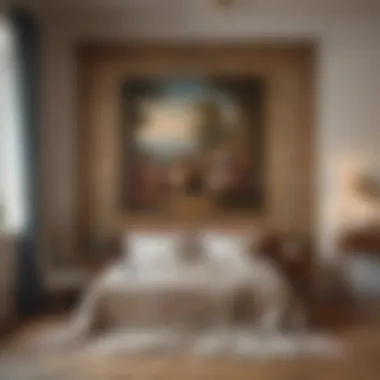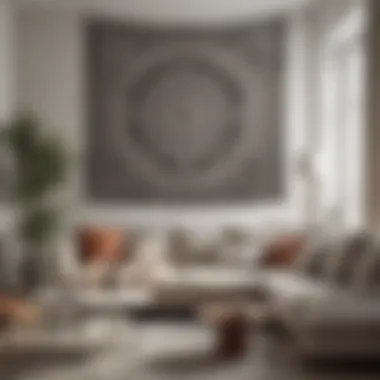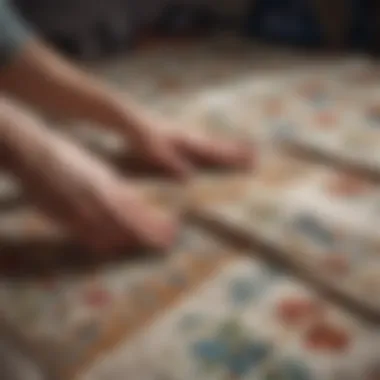Linen Tapestry: A Distinctive Wall Decor Choice


Intro
Linen tapestry, a term that sparks visions of artistic craftsmanship and sophisticated decor, blends history, style, and functionality in interesting ways. For many, wall decor can feel like an afterthought; yet, linen tapestries have elevated this notion, presenting themselves not just as mere decorations but as versatile elements that breathe life into spaces.
Historically speaking, linen has been around for ages. Its origins trace back to ancient civilizations, where it was prized for its durability and natural beauty. Today, the revival of linen tapestry reflects a growing appreciation for outdoor-inspired aesthetics and handmade artistry. This comprehensive exploration will highlight the allure of linen tapestry by looking into its rich history, the various material benefits, and how it finds its place in modern homes.
As we continue through the article, we’ll touch on how one should select their linen tapestry, tips for maintaining it, and the best strategies for placement. This is not just about draping something on a wall; it’s about curating an environment that resonates with personal taste and comfort.
Preface to Linen Tapestry
The world of interior design is an ever-evolving space where creativity knows no bounds. One of the striking elements that has carved a niche in wall decor is linen tapestry. Linen tapestry is not just about embellishing a wall; it's about weaving stories, emotions, and heritage into the very fabric of our living spaces. In this section, we explore the significance of linen tapestry, its multifaceted benefits, and considerations that make it an essential topic in the realm of home decoration.
Understanding Tapestry Art
Tapestry art dates back to ancient civilizations, where it served various purposes, from narrative storytelling to enhancing the aesthetics of royal palaces. It’s a blend of utility and artistry, capable of transforming a plain wall into a canvas of expression. Each piece tells its own tale, often depicting intricate scenes from folklore, history, or nature.
- Cultural Narratives: Tapestries can represent the rich tapestry of cultural stories, distinguished by their patterns and symbols derived from various traditions.
- Functionality: Beyond visual appeal, tapestries absorb sound and help in temperature regulation, creating a cozy atmosphere in homes.
- Craftsmanship: The careful craftsmanship behind tapestry weaving is an art form in itself, showcasing skills honed over generations.
As one studies tapestry art, it becomes clear that it is more than just decoration—it is a manifestation of cultural identity and personal taste. Choosing a linen tapestry, therefore, can connect you to a wider narrative, inviting an appreciation for the artistry involved in its creation.
The Role of Linen in Tapestry
Linen has long been revered for its qualities that enhance tapestry making. The fabric has some unique characteristics that make it a preferred choice.
- Natural Fiber: Linen is derived from the flax plant, making it an organic material that is both aesthetically pleasing and durable.
- Dyes and Texture: Its ability to absorb dyes deeply allows for vibrant colors that don’t fade easily. The texture of linen adds depth to designs, showcasing intricate weaves and patterns beautifully.
- Environmental Considerations: Given current trends toward sustainable choices, linen stands out as an eco-friendly option. Its production has a lower environmental impact compared to synthetic fibers.
"When selecting art for your home, remember that linen tapestry is like a fine wine; it gets better with age, telling stories of wear and beauty for generations to come."
Considering linen’s essential traits helps in understanding why it is a preferred material for creating exquisite tapestry art. Such choices reflect a commitment not just to aesthetics, but to sustainability and quality, making linen tapestry a worthwhile addition to any home.
The Historical Context of Tapestry
Tapestry has an enthralling history that transcends mere decoration, acting as a canvas where stories, beliefs, and cultures intertwine. Understanding the historical context of tapestry is crucial for anyone looking to appreciate linen tapestry's depth in wall decor. Beyond aesthetics, these woven artworks reveal social hierarchies and influence artistic trends, connecting us with the past in vivid, tactile ways.
Origins of Tapestry Weaving
The art of tapestry weaving can be traced back to the ancient civilizations of Egypt and Mesopotamia. These cultures utilized weaving techniques primarily for functional textiles, yet as time unfolded, the craft evolved into a sophisticated form of artistic expression. One noteworthy example is the use of tapestries in the medieval period, where they adorned the walls of castles and churches. Here, tapestries served not just as decoration, but also as insulation against cold stone walls and as storytelling devices.
Notably, the famous Bayeux Tapestry, crafted in the 11th century, depicts the Norman Conquest of England and remains a pioneering example of narrative embroidery. This work influenced many future artists, showcasing how tapestries could convey stories in a visually captivating manner. The originality of weaving allowed artisans to create intricate designs, drawing viewers into the narratives woven into the fabric.
Linen in Historical Textiles
Linen, while not the only material used in tapestry, holds a significant place in the history of textiles. Made from the fibers of the flax plant, linen has been utilized since ancient times, known for its strength and texture. The Egyptians famously employed linen for mummification due to its durability and breathability. However, it was during the Middle Ages that linen became highly prized for tapestry weaving.
Its fine quality made it suitable for detailed designs that required intricate patterns. Tapestries made from linen often showcased the craftsmanship of skilled weavers and were favorites among the nobility. They took on roles beyond mere beauty; these tapestries reflected status and wealth, marking the distinction of households. It was common for wealthy families to commission bespoke works as a symbol of their power and influence.
In summary, the historical importance of linen tapestry lies not only in its visual beauty but also in its ability to convey complex narratives and social commentary. Each piece represents the zeitgeist of its time, inviting us into the lives and values of those who came before us. As one delves into the world of linen tapestries today, one cannot help but feel the weight of history imbued in each thread.
Material Advantages of Linen
When discussing linen tapestry, one cannot overlook the distinct advantages that the material offers. Linen, derived from the flax plant, is not just another fabric—it is a testament to craftsmanship, longevity, and sustainability. This section peels back the layers of linen’s material attributes, demonstrating how they contribute to its desirability as wall art. The benefits stretch far beyond aesthetics, affecting durability, comfort, and ecological impact.
Durability and Longevity
Linen is often hailed for its remarkable durability. Unlike many fabrics that wear out quickly, linen becomes more resilient with age. Its fibers become softer and gain character, enhancing the tapestry's charm over time. In everyday terms, if you hang a linen tapestry, you’re not just adding flair to your walls; you're investing in a piece that stands the test of time.
- Resistant to Fraying: Linen fibers possess a natural ability to resist fraying, so it won't easily tear or fade, even in less-than-ideal conditions.
- High Tensile Strength: Linen has one of the highest tensile strengths among natural fibers, which allows it to maintain its integrity over years of being displayed.
- Antimicrobial Properties: Interestingly, linen doesn’t harbor bacteria as easily as other fabrics, making it a healthier choice for indoor environments.
This enduring quality makes linen tapestry particularly excellent for busy homes, where exposure to sunlight and everyday wear is inevitable.
Breathability and Temperature Regulation
Another critical advantage of linen is its superior breathability. This property allows the fabric to interact with its surrounding atmosphere, offering comfort in various conditions.


- Moisture-Wicking: Linen absorbs moisture efficiently, pulling it away from the body to keep the environment dry. This means that during warmer months, your space feels fresher, while in cooler seasons, it can help maintain warmth.
- Temperature Control: The natural fibers of linen allow for better air circulation, which helps in regulating indoor temperature. Essentially, linen tapestries help your walls breathe—no stuffiness here!
- Hypoallergenic: The breathable nature of linen also contributes to its hypoallergenic qualities, making it suitable for individuals susceptible to allergies.
These features ensure that a linen tapestry isn’t just a pretty face; it serves practical purposes in enhancing comfort and overall air quality in your home.
Eco-Friendliness of Linen
In a world increasingly focused on sustainability, linen tapestry holds a unique place as an eco-friendly textile choice. As consumers become more environmentally conscious, the production methods and lifecycle of materials come under scrutiny. Linen checks all the boxes for green materials.
- Biodegradable: After its life as a tapestry, linen will naturally decompose, leaving no harmful residues behind—a win for Mother Nature.
- Sustainable Farming: Flax, the source of linen, requires minimal water and pesticides compared to cotton or synthetic fibers. This efficiency means less environmental impact during the cultivation phase.
- Low Carbon Footprint: The manufacturing process of linen is less energy-intensive, making it a better choice for those concerned about their carbon footprint.
"Choosing linen is not just about aesthetic appeal; it's a conscious decision that respects the environment and promotes sustainable practices."
In summary, the material advantages of linen—its durability, breathability, and environmental considerations—offer compelling reasons to choose linen tapestry for wall decor. It’s not just about dressing your walls; it’s about making intelligent, informed choices that resonate with personal values and global responsibility.
Aesthetic Appeal of Linen Tapestries
The aesthetic allure of linen tapestries holds a pivotal place when it comes to wall decor. They are not just pieces of art but also embody a sense of identity and emotion, often reflecting personal narratives or cultural heritage. Linen tapestries can serve as conversation starters, drawing the eye and inviting admiration. In an era where minimalist decor reigns, the tactile qualities and intricate designs of linen tapestries offer a refreshing contrast, enhancing the visual drama within any space. They bring warmth and texture, transforming stark walls into inviting backdrops.
Textures and Patterns in Design
Textures play a huge role in the appeal of linen tapestries. The fabric's natural weave can create an intriguing depth that changes with the light. Lush, intertwined patterns may evoke the feeling of nature, while abstract designs might inspire a modern vibe. The varying twisting of fibers can deliver everything from smooth to rough textures, making the tapestry itself a sensory experience. When choosing a linen tapestry, consider how the texture encourages touch and interaction.
- Opt for geometric shapes to modernize a traditional setting.
- Select floral patterns for a touch of femininity.
- Explore symbolic designs that draw upon cultural narratives.
Patterns in linen tapestries also hold significant weight in conveying stories and emotions. They represent different cultures and their historical contexts, adding layers of meaning to the decor. When hung, these pieces often suggest a narrative, allowing the viewer to delve into their intricacies, remembering that good design does not just please the eye but also respects the soul.
Colors and Themes in Tapestry Art
Color is another significant element in the aesthetic impact of linen tapestries. The palette you choose can create distinct atmospheres; softer hues promote tranquility, while bold colors stimulate energy. The choice between muted tones and vibrant shades should reflect the room's purpose. For instance, a cozy reading nook may benefit from warm tones, making the space feel inviting and comfortable. In contrast, a bright, dynamic tapestry in a living area can inspire creativity and conversation.
- Earthy tones connect to nature, grounding the space.
- Rich jewel colors can serve as focal points.
- Monochromatic schemes ensure a streamlined sophistication.
The themes depicted in tapestries also play a role. Nature-inspired designs often add a layer of serenity and organic beauty to interior spaces. Alternatively, abstract themes stimulate thought and discussion. By selecting themes that resonate with your values or interests, the tapestry can become more than just decoration; it becomes a statement piece, imbuing the atmosphere with your unique essence.
Cultural Significance in Artistry
Linen tapestries are imbued with deep cultural significance, acting as a bridge to historical narratives and artistic expressions from around the world. Each tapestry can tell a story that spans generations, often linking modern viewers to the artistry of the past. For example, traditional Hungarian tapestries often depict landscape scenes that reflect the country's rich agricultural heritage, while Chinese tapestries may illustrate intricate mythological stories, weaving culture and artistry into a single piece.
This cultural backdrop not only enhances the tapestry's aesthetic appeal but also invites discussion about its origin, purpose, and significance. Collecting or displaying linen tapestries can be viewed as a commitment to preserving these artistic traditions, contributing to a cyclical appreciation of art and culture.
"Linen tapestries provide not just beauty but also a rich narrative woven through history, culture, and personal expression."
As we explore the aesthetic aspects of linen tapestries, remember that they embody more than just visual charm; they carry stories, sentiments, and traditions, making them a unique addition to any space.
Choosing the Right Linen Tapestry
Choosing the right linen tapestry can feel like finding a needle in a haystack, especially with the endless choices available today. But picking the right piece can turn your space from bland to beautiful. Linen has its own charm, and getting the right tapestry is a matter of knowing what suits your tastes and requirements. A well-chosen linen tapestry serves not only as decoration but also enhances the room’s ambiance and vibe.
Identifying Quality Linen
When on the quest for quality linen tapestry, several key indicators speak volumes. Start by checking the fiber composition. Genuine linen should have a noticeable texture and feel distinctively cool to the touch, while synthetic alternatives may feel too smooth or slick. Additionally, check for the finishing. Quality pieces usually come with neat and sturdy finishing, avoiding loose threads that can unravel over time.
Look for the weight of the fabric as well. Heavier weight linen often translates to better durability. If a tapestry is too light, it might be more prone to wrinkles and wear. Furthermore, expert craftsmanship shines through in intricate details—consider stitching quality and the clarity of the design. These elements can often give away the true worth of your tapestry.
Sizing and Dimensions Considerations
Size matters, especially when it comes to tapestry placement. A tapestry that’s too small might get visually lost on a bigger wall, while an overly large piece can overwhelm a small space. Therefore, measuring your wall first is vital. Here are some quick tips:
- Standard Sizes: Familiarize yourself with standard tapestry sizes; often, common dimensions range from small 30x40 inches to large 70x100 inches.
- Proportions: Aim for proportionality. A tapestry should take up approximately two-thirds of your wall space for a pleasing aesthetic.
- Placement: If you're hanging it above furniture, consider height. Ideally, the center of your tapestry should sit at eye level.
Remember, don’t be afraid to use multiple smaller tapestries to create a unique display rather than one big piece. This adds layering and texture to the decor.
Selecting a Design that Resonates
Selecting a design that resonates with your personal style or the room's theme is crucial. Linen tapestries come in a myriad of designs from minimalist patterns to elaborate scenes. Here are a few points to ponder when selecting:


- Themes and Colors: Think about the existing color palette in your space. A tapestry should ideally complement or enhance the current aesthetics rather than clash with them. Whether warm tonesหรือ cool hues, ensure the tapestry contributes to the harmony of the room.
- Personal Connection: Select a design that strikes a chord with you. Perhaps it evokes a fond memory or simply captures an interest, like landscapes or abstract art.
- Contextual Significance: Consider how the tapestry reflects the room’s purpose. A calming design works great in a bedroom while bold patterns might be perfect for a lively living room.
Ultimately, a tapestry should feel like a piece of you. Opt for designs that not only look good but also tell a story, adding layers of meaning to your wall decor.
"A tapestry isn’t mere fabric; it's a reflection of your thoughts and feelings woven into art."
Placement and Display Techniques
Understanding how to effectively place and display linen tapestries is crucial for accentuating their beauty and enhancing your living space. The right placement ensures that the tapestry becomes a focal point in a room, drawing attention and sparking conversation. Display techniques not only affect the aesthetic appeal but also the overall atmosphere of your environment.
Wall Placement Strategies
When deciding where to hang your linen tapestry, consider the size and shape of the wall. Large, expansive walls work well for bigger pieces, creating a bold statement. On the other hand, smaller walls might benefit from narrower or vertically oriented tapestries. Don't forget to account for furniture placement as well. A tapestry hung above a sofa or bed can create a harmonious balance in a room.
To achieve the best visual impact, keep the following in mind:
- Height: The ideal height for hanging art is at eye level, usually around 57 to 60 inches from the floor.
- Symmetry: Consider grouping smaller tapestries together to form a cohesive look, or offset a larger piece with smaller accessories.
- Natural light: Avoid placing your tapestry in direct sunlight, as this can fade the colors over time.
Framing vs. Hanging Techniques
The method you choose to display a linen tapestry can greatly influence its presentation. Framing can add a polished look, protecting the fabric while elevating the overall style. Consider using a shadow box frame for three-dimensional textiles, allowing the tapestry to breathe without losing its depth. On the other hand, hanging techniques provide a more casual or artistic flair. Here are some popular options:
- Rod and rings: This classic approach allows for easy movement and versatility in styling.
- Tapestry clips: These are ideal for smaller pieces, offering a minimalist approach without any additional hardware.
- Magnetic hangers: They provide a modern twist and are easy to swap out when you want to refresh your decor.
Creating Complementary Environments
The tapestry itself is just one element of the decor. Creating a complementary environment takes thoughtful consideration of colors, textures, and themes throughout the space. Consider the room's color palette when selecting your tapestry. A striking piece can serve as an anchor, leading your design choices. Add accent pieces that resonate with the artwork—this could be cushions, throws, or even artwork that shares similar color tones or motifs.
Additionally, blend textures by integrating materials such as wood, metal, or ceramics into the space. For instance, a linen tapestry featuring a natural scene may be beautifully paired with a rustic wooden frame or side table. This interplay between different elements can bring a sense of cohesion and harmony to your room.
“A tapestry is not just a piece of fabric; it is a narrative woven into the very fabric of your home.”
By keeping these placement and display techniques in mind, you can transform your linen tapestry into a centerpiece that enriches your living environment, inviting both admiration and reflection.
Maintenance and Care for Linen Tapestries
When it comes to linen tapestries, their charm is not just in their beauty but also in the stories they embody. However, to maintain that allure, proper care is essential. Linen is a natural fiber that, despite being robust, requires some tender loving care to withstand the test of time. Engaging in regular maintenance not only preserves the tapestry's vibrancy but also enhances its longevity. This pivotal aspect deserves attention, particularly for those who understand the worth of investing in quality decor.
Cleaning Methods and Recommendations
Proper cleaning is vital to keep your linen tapestry looking fresh and free from dust or stains. Here are some cleaning methods tailored specifically for linen tapestries:
- Dusting Regularly: Using a soft brush or a lint roller can effectively remove dust. Regular dusting stops the build-up that could lead to discoloration over time.
- Spot Cleaning: For small spills, it's best to act swiftly. Blot the stain gently with a clean, damp cloth. Avoid rubbing, as this can damage the fibers. Use a mixture of mild soap and water for stubborn stains, but do a patch test first to ensure no unwanted reactions occur.
- Professional Cleaning: When your tapestry undergoes significant wear or needs deep cleaning, seek professional help. They possess specialized knowledge and tools, ensuring that the tapestry gets cleaned without risking any damage.
- Proper Storage: If you plan to store your tapestry, ensure it's rolled up, not folded. Store it in a cool, dry place and away from direct sunlight to prevent color fading.
"A well-cared-for tapestry is like a tale that continues to unfold with beauty."
Repair and Restoration Techniques
Over time, even the most cherished artifacts can encounter wear and tear. Linen tapestries, although durable, are not immune to fraying or damage. Here are some techniques to breathe new life into your tapestry:
- Repairing Small Holes: Use a patch of similar linen fabric. Sew it carefully over the worn area using a thread that matches the tapestry's color. This method is discreet and helps maintain the tapestry's integrity.
- Dealing with Frayed Edges: For fraying, a simple stitch can keep the fibers intact. If a significant section is frayed, consider reinforcing it with a backing of lightweight fabric. This maintains the tapestry's aesthetic while ensuring durability.
- Reweaving: If damage is extensive, sometimes reweaving is necessary. Although it requires skill, this approach can restore the tapestry to its original glory. If you're unsure, hiring an experienced artisan is advisable.
- Dry Cleaning for Restoration: In cases of discoloration or heavy soiling, dry cleaning is an option, but approach this carefully. Always consult with professionals who specialize in textile restoration to avoid complications.
These techniques ensure that your linen tapestry not only tells its story but continues to do so, beautifully and timelessly.
The Modern Usage of Linen Tapestry
In the interior design landscape of today, linen tapestries have emerged as a versatile and aesthetic choice, marrying functionality with striking visual appeal. They serve not only as decorative elements but also as enhancers of a room's ambience. Many enthusiasts and designers alike now recognize the importance of linen tapestries in creating a cohesive look while also considering their practicality.
Linen Tapestry in Contemporary Decor
The role of linen tapestry in contemporary decor cannot be overstated. With its unique texture and durability, it compliments various styles ranging from minimalistic to bohemian chic. Linen, in its natural state, brings a touch of warmth that synthetic materials often lack. This quality is particularly effective in modern settings, where stark contrasts can sometimes feel cold or unwelcoming.
Further, linen’s capacity to adapt to different color schemes enhances its compatibility with contemporary designs. For instance, a muted blue linen tapestry can soften an otherwise stark white wall, creating a feeling of calmness. Similarly, bold patterns can serve as statement pieces, adding depth to spaces dominated by neutral tones. As such, decorators are increasingly regarding linen tapestry as an essential tool in their arsenal for achieving balanced decor.
"Tapestries are not merely wall hangings; they are visual narratives that speak to the soul of a space."


Incorporating into Various Design Styles
Linen tapestries offer a remarkable adaptability across a range of design styles. Whether one prefers the sleek lines of modernism or the intricate details of traditional decor, linen can fit the bill. Here are a few ways to incorporate linen tapestries into various aesthetics:
- Minimalism: In minimalist settings, a simple linen tapestry with subtle tonal variations can add an understated elegance without overwhelming the senses.
- Bohemian: Bohemian styles can benefit from vibrant, eclectic linen tapestries that serve as conversation starters, drawing attention to creative arrangements.
- Rustic/Traditional: For rustic or traditional spaces, tapestries depicting pastoral scenes or historical motifs enrich the room’s narrative, providing depth and character.
Here are some considerations for integration:
- Consider size and scale; a large tapestry can anchor a room, while smaller pieces can complement existing decor.
- Always think about color harmony—select tapestries that resonate with other elements to create a unified aesthetic.
Ultimately, linen tapestries offer a flexible, stylish solution while allowing the designer's creativity to shine through. With a thoughtful selection, they provide not just beauty but also the potential to transform spaces into personalized sanctuaries.
The Functionality Beyond Aesthetics
When one thinks about linen tapestry, the first imagery that comes to mind is often tied to aesthetics—vibrant colors, intricate designs, and that subtle texture that seems to add depth to a room. However, linen tapestry serves a purpose beyond mere beauty, enhancing spaces in ways that are both practical and beneficial to our living environments. Let’s explore how linen tapestry does its duty quietly, making it not just a decorative element but also a functional asset.
Acoustic Properties of Linen
A lesser-known benefit of linen tapestry is its acoustic properties. Walls often reflect sound, leading to echoes and a more boisterous environment that can be distracting or even uncomfortable. In contrast, linen tapestries act as natural sound absorbers. The fabric's density and texture help to soften sounds, reducing echoes and creating a more serene atmosphere.
- Sound Dampening: The fibers in linen trap sound waves, which means that whether you're entertaining guests or simply enjoying a quiet evening, the ambiance can be greatly improved.
- Layered Softness: By incorporating linnen tapestry into your interior spaces, you add a layer of softness that can tone down harsh noises. This is beneficial particularly in open-concept homes where sound can travel freely.
In essence, not only does a linen tapestry enhance the visual appeal of a room; it also creates an acoustic harmony, making spaces feel more welcoming and calm.
Insulation Benefits in Interior Spaces
Linen tapestry contributes to energy efficiency in a more subtle way by helping with insulation. Traditionally, textiles have been known to assist with temperature regulation within rooms. Here’s how linen excels in that regard:
- Thermal Insulation: Linen has natural insulating properties, helping to maintain a consistent temperature in your home. This is particularly advantageous in both chilly winters and warm summers, potentially lowering energy costs.
- Preventing Heat Loss: Hanging a linen tapestry can act as an additional barrier against cold drafts, adding a layer of protection to your walls that are otherwise exposed.
- Warmth in Design: Beyond functionality, the warmth of a linen tapestry adds to the overall coziness of room decor, making the environment feel inviting.
"A well-placed linen tapestry not only speaks to design but to comfort in every sense of the word."
Linen Tapestries: A Sustainable Choice
In today’s world, where sustainability often takes center stage in discussions around home decor, linen tapestries emerge as a beacon of eco-friendliness. The choice to decorate with linen is not merely an aesthetic one; it's deeply entwined with environmental and ethical dimensions that resonate with socially-conscious consumers. Understanding these facets can enhance one’s appreciation for linen tapestries and motivate a shift towards sustainable living.
The Environmental Impact of Linen Production
Linen is derived from the flax plant, which boasts a remarkably low ecological footprint. Unlike cotton, flax cultivation demands less water and fewer pesticides, rendering it a much cleaner choice for the planet. This hardy plant flourishes in diverse climates and can grow in poor soil, which minimizes the need for chemical enhancements. Moreover, flax's ability to naturally suppress weeds means farmers can employ fewer herbicides during cultivation.
The fiber extraction process is notably efficient. Flax plants yield high volumes of fiber relative to the land area used for cultivation. After the harvest, almost every part of the plant can be utilized — from seeds that produce oil to stalks that can become compost or biofuel. This not only maximizes use but also minimizes waste, fostering a cycle of sustainability.
It’s important to note that by choosing linen, consumers contribute to a model of agriculture that is much easier on the planet. The ripple effect of this choice can extend far, influencing sustainable practices in the textile industry at large.
Supporting Ethical Craftsmanship
In addition to its environmental benefits, linen tapestry production often supports ethical craftsmanship. Many artisans and small workshops specialize in creating linen tapestries, and often these workshops are located in regions where traditional weaving techniques have been passed down through generations. By purchasing linen tapestries from reputable sources, consumers are not just acquiring a beautiful piece of art; they are endorsing fair labor practices and supporting local economies.
When sourcing linen tapestries, it becomes crucial to inquire about the origins and methods of production. Look for certifications that guarantee ethical practices. Such certifications often indicate that artisans are compensated fairly and work under safe conditions. By prioritizing purchases from these sources, individuals can enjoy pieces of artistry while standing against exploitative practices in the textile industry.
"Sustainability isn't just a trend—it's a shift in how we understand our connection to the world. Choosing linen means weaving a story that values both artistry and the earth."
Choosing linen tapestries means making thoughtful decisions that honor the environment while promoting social responsibility. With each tapestry hanging in one’s home, a narrative unfolds, promoting not only individual aesthetics but also collective accountability towards a more sustainable future.
Epilogue: Appreciating Linen Tapestry
Linen tapestry is much more than mere decoration; it embodies a blend of artistry, history, and craftsmanship that speaks to the soul of a space. Understanding its significance helps not only in appreciating its aesthetic appeal but also in recognizing its role as a timeless element in interior design.
The lasting impact of linen art can be observed in numerous settings. Whether one is drawn to vintage styles or modern minimalist designs, linen tapestries offer an adaptable solution. They effortlessly bridge the gap between old-world charm and contemporary flair. One benefit is the way these pieces serve as conversation starters. A well-placed tapestry can intrigue guests and spark discussions about art, culture, or personal stories behind its selection.
- Cultural Heritage: Each linen tapestry is steeped in tradition, reflecting various cultural narratives. For instance, a tapestry depicting pastoral scenes could ignite an appreciation for rural life and traditions.
- Eco-Friendly Choice: Linen, derived from the flax plant, embodies the principles of sustainable living. Its biodegradable nature ensures that decorative choices can align with eco-conscious values without compromising style.
"The beauty of linen tapestries lies not only in their visual richness but in their capacity to inject personality and history into any room."
Equally important is how tapestries encourage personal expression. They offer a canvas on which thoughts, feelings, and creativity can be recorded. Rather than opting for mass-produced pieces, individuals can curate a collection that resonates deeply with their identity. This personal touch transforms spaces into reflections of one’s journey and experiences.
Consider these aspects when choosing a tapestry:
- Meaningful Imagery: Selected images or patterns can hold significance, perhaps illustrating personal milestones or aspirations.
- Color Schemes: Colors evoke emotions. A bright, vibrant tapestry may energize a room, while softer hues create tranquility.
In summary, linen tapestries not only enhance visual appeal but serve as vessels for storytelling and self-expression. Their adoption into personal spaces reaffirms the connection between art and life. As you stand back and admire the artistry, take a moment to appreciate the layers of meaning each tapestry can bring to your home and heart.















